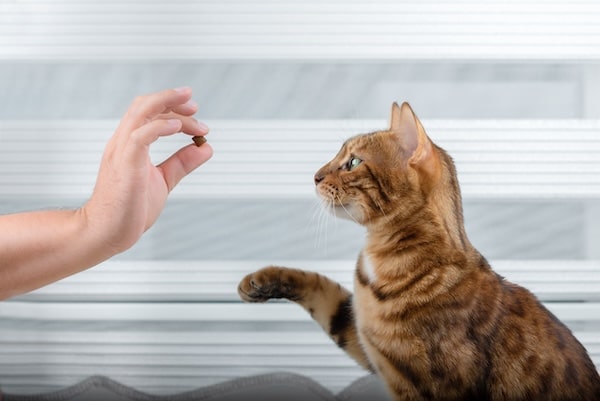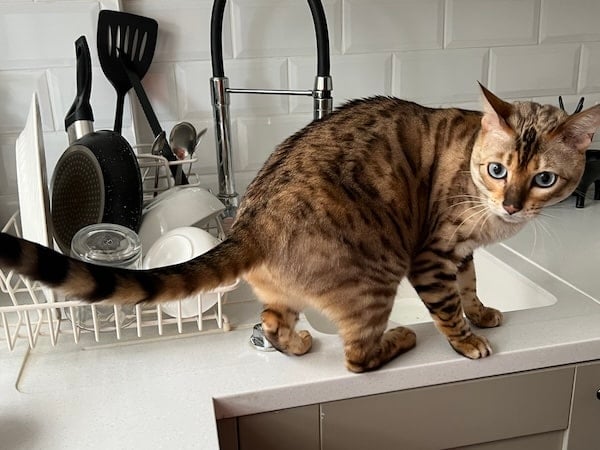- Not a substitute for professional veterinary help.
Dogs get all the attention when it comes to training, but cats can be just as biddable. Clicker training for cats is especially effective for teaching your kitty new tricks, encouraging preferred behaviors, and promoting mental stimulation.
Clicker training works by marking the exact moment your kitty does what you want with a click—and pairing the sound with a positive reward, like a treat. This helps your cat quickly learn what behavior wins them a snack. It establishes clear communication and reduces frustration, which is vital for more independent learners like cats.
While it’s best to clicker train as young as possible, you can start at any age. Whether you have a young kitten or a senior cat, we’ll guide you through the training basics. With the help of two certified cat behaviorists, we’ll discuss what you can teach, how to introduce a clicker, how to shape behavior, and what tools you’ll need.
What Can You Teach a Cat?
According to Joey Lusvardi, a certified cat behavior consultant at Class Act Cats, you can teach your cat to do “almost anything they’re physically capable of doing.” Some common behaviors you can train include:
- Sitting
- Staying
- Coming when called
- Going to a particular place
- Walking on a leash
- Getting comfortable in a carrier
- Tricks like giving a high five, spinning, turning off a light switch, ringing a bell, and standing on two legs
- Stopping biting
- Stopping scratching (people and on furniture)
- Stopping counter surfing
- Preventing cats from fighting
Why are clickers good for training cats?
Evidence shows that learning basic cues through clicker training gives cats an enriching and social activity, which can also help reduce stress. But why exactly does it work so well? Couldn’t you just give your cat a treat anytime you like what you see? Why the click?
The answer, Lusvardi explains, is that it’s predictable. “Cats are great at picking out patterns, so many of them will catch on quickly if you know what you’re doing,” he says.
And more importantly, it’s immediate, as Stephen Quandt, a certified feline training and behavior specialist at Cat Behavior Help, points out. “Cats are smart in many respects, but their brains are the size of walnuts,” he says. “They’ve learned that a reward is directly connected to an action. If you separate the behavior from the reward by more than the briefest of moments, they don’t get the connection.”
Clicking is much faster than giving a treat. It buys pet parents and trainers a bit of time to hand over the reward without losing that critical connection. “Since it can be hard to reward the cat at exactly the moment they do the thing we want them to do,” Quandt adds, “clicking allows us to precisely time the click to the desired action.”

Svetlana Sultanaeva via iStock
How To Introduce a Cat to a Clicker
Before you start rewarding specific behaviors, your cat needs to know that a click equals all the good things. To create this connection, follow these four steps.
- Step 1: Sit on the floor with the clicker in one hand.
- Step 2: Have high-value cat treats readily within reach.
- Step 3: Call your cat over. When you have their attention, click and immediately give your cat a treat.
- Step 4: Do this several times and repeat sessions until your cat begins to associate the sound of the clicker with a reward/treat.
You’ll know your cat has made the association when they hear the click and immediately look for the reward.
How To Shape Your Cat’s Behavior
“Shaping” is an animal training technique that breaks a new behavior into small, gradual steps that build toward the final action. Here’s a look at how shaping works with common tricks.
Sit
Start by holding a treat close to your cat’s nose where they can smell it (but not eat it yet!). Next, move the treat over their head and back, helping them naturally fall into a sitting position. As soon as their rear hits the ground, click and give them the treat.
Stay
Once your cat knows how to sit, you can take shaping even further and teach them how to stay. Put them in a sit position before making the slightest move away. Click and reward immediately. Slowly increase your distance away, marking each time your cat is successful.
High five
Position your cat in front of you. Hold a treat in front of their shoulder. If your cat reaches out to tap your hand, immediately click and treat. (If your cat doesn’t reach out automatically, tap your hand holding the treat with your other hand to help guide them.)
Touch/target
Choose a strong-smelling cat treat, like freeze-dried salmon. Let the scent get on your hand before putting the treat away. Hold your now delicious-smelling finger in front of your cat. As soon as they come close to investigate, click and give them the treat. Slowly build up enough momentum so your cat eventually touches their nose to your finger.
Spin
Once you have your cat’s attention, show them the treat. Next, gradually move it in a circle at eye level, going slowly so your cat follows. As soon as they make a complete circle, click and give them the treat.
How To Introduce a Cue
Cues are the words or hand signals you assign to a certain behavior, like saying “sit” to prompt your cat to, well, sit.
Remember, though, if your cat has never heard the word “sit,” they won’t know what to do. While it sounds obvious, it’s easy to forget that you have to build the behavior first. “Get the cat doing the behavior reliably, then pair the cue with the behavior,” explains Lusvardi.
To teach a cue, say it right before the behavior is performed. For example, if your cat can reliably sit via shaping/luring, say the cue right before they sit down. Then click immediately and reward once they do.
Once a cat understands that certain words are tied to certain behaviors, it gets easier to introduce new cues.
How To Use a Clicker to Stop Behaviors
Along with teaching tricks and cues, clicker training for cats is great for stopping unwanted behaviors. “You can train the cat to do an alternative behavior or something that’s incompatible with a behavior you don’t want them to do,” says Lusvardi. In other words, think about what you want your cat to do instead and teach that.
This, however, requires a few prior steps. First, you’ll want to identify the function behind the behavior. Why is your cat doing what they’re doing? For instance, is your cat jumping on the counter to scavenge for food, or are they doing it to get your attention? Your cat’s motive will determine what steps you take to redirect the behavior.
Creating a management plan also helps keep your cat from rehearsing and reinforcing the unwanted behavior before you teach a new one. For example, if your cat is jumping on the counter for food, you can put them in a different area of the house with a food puzzle while you’re cooking.
And finally, as you teach a new behavior, make sure you’re using high-value treats and things your cats love. “In order to work, the cat’s desire for the reward has to be greater than their need to engage in the behavior you’re trying to curb,” Quandt says.
With that in mind, here are some tips on how to use clicker training to stop common problem behaviors.
Biting
For cats that bite, Lusvardi suggests teaching them how to interact with you in a calm, controlled manner instead. “I have a lot of my clients train their cats to high five or touch their nose to your finger as a way to stop biting,” he explains. “The cat can’t be both biting you and having their nose on your finger.”
If your cat is biting when you handle them, like during brushing or putting on a harness, you can use clicker training to create positive associations with the item or the act.
For instance, if your cat goes for your hand when you brush them, start by placing the brush on the ground. Click and treat your cat for any interaction with the brush. Then, slowly get your cat used to the brush coming closer to them until it’s gently touching their body. Keep clicking and rewarding for each successful progression until you can brush without biting.
Scratching
If your cat is using their claws against you or other humans as a way to interact, you can again teach a high five, touch, or other cue to redirect scratching. But if they’re scratching your furniture for attention or out of boredom, they likely need a different outlet.
Place a sturdy scratching post near the couch or wherever your cat digs in her claws and click and treat every time they use it instead—until it becomes their behavior of choice.
Counter surfing
“With counter surfing, you can encourage the cat to get off on cue or go sit on a cat tree instead of your counters,” says Lusvardi. By creating a new spot and rewarding them heavily when they go there, your cat will start to realize that going to that place (and not on the counters) will get them the response (food or attention) they actually want.

Darko Mlinarevic via iStock
Tools to Start
Ready to start clicker training? Here are some things you’ll need, as well as some items that are optional but can elevate the training experience.
- A cat-appropriate clicker. Many clickers are designed for dogs, and the loud sound may be too much for some kitties to handle. Look for a quieter clicker that still makes a clear sound but won’t overwhelm your cat.
- Treats. When it comes to rewards, your cat gets to decide what’s reinforcing and what’s not. Many trainers recommend using high-value cat treats, like small pieces of cooked shrimp. If that doesn’t work for you or your cat, you can choose any treat that motivates them.
- Other rewards. Some cats may not find food as reinforcing as others and will prefer other rewards, such as praise, play, a head scratch, or a favorite toy. Lusvardi encourages getting creative and following your cat’s lead. “I’m currently working on training one of my cats to high-five me in exchange for allowing him to bump foreheads with me,” he says. “He’s more okay with high five in exchange for that than he is for a treat.”
- Treat pouch. Having your treats readily available in a treat pouch can help with your delivery time, reinforcing quickly after the click.
- Target stick. This tool is great for helping position your cat and shape different behaviors once you train them to touch it with their nose. Plus, it’s pretty cute to see your kitty boop the end.
- Food puzzle. Puzzle toys, snuffle mats, and lick mats are excellent enrichment items that can help reinforce your cat to stay in a preferred area of the house and out of certain areas, like on your kitchen counter. They’re also excellent for introducing cats to one another for the first time, helping build positive associations around each other.
As your cat’s clicker training progresses, you may want to expand beyond simple tasks. Lusvardi particularly likes pattern games, such as the Control Unleashed series from certified dog behavior consultant Leslie McDevitt. Though they’re designed for dogs, Lusvardi says the series is also popular with cat trainers.
If you’re struggling with clicker training, a certified cat trainer or behaviorist can be a great resource, whether you work with them online or hire them for in-person help.
Top Tips for Clicker Training
When it comes to how long you should train your cat, Quandt recommends keeping sessions short, no more than five minutes twice a day. It’s not about learning fatigue, he says. It’s that cats simply don’t have long attention spans.
Keep things simple, too, breaking down behaviors into manageable steps each session. Once your cat has more tricks up their sleeve, you can start the session with the tricks they already know to build confidence before teaching them something new.
Make sure your mechanics are clean, too. For clicker training to work effectively for cats, you need to click precisely when your cat performs the behavior you want to see. Your delivery time also matters. Always give your cat a treat immediately after the click so your cat knows what behavior is being rewarded.
“Think of it as taking a photo of the behavior,” explains Lusvardi. “When you click, the cat will make the connection between what they just did and whatever form of reinforcement they get.”
Clicker training at any age
While very young cats may not be ready for clicker training, Lusvardi says there’s no upward age limit to using the technique.
Kittens may do best with simple tasks, but you can increase the complexity as they grow and understand more about the world around them. Lusvardi recommends starting small with older cats, too, especially if they’re not used to training in general. Beyond that, the sky just might be the limit.
“I was training with my last cat right up until he passed just shy of 14,” Lusvardi says.
After all, nobody says you can’t teach an old cat new tricks.



